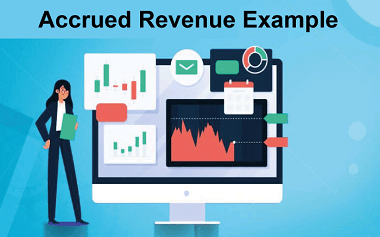Accrued Revenue: Definition, Examples, and How To Record ItWhat exactly is Accrued Revenue?Accrued revenue is income generated through the delivery of a product or service, but pending payment has not yet been received by the supplier. As a result, accrued revenue is recorded as a receivable for the client's owing business transaction. 
For example, a SaaS company may acquire a customer who demands a service over the next six months. The firm may agree to deliver the service for $1,000 and issue an invoice at the end of the month, due on the 15th of the following month, according to the contract terms. From that point until the conclusion of the contract, the SaaS provider will have generated $1,000 in accrued revenue from that specific customer, which will be paid after the service completes, or after six months. In-depth Understanding of Accrued RevenueAccrued revenue is primarily involved in accrual accounting, revenue recognition and matching criteria. Revenue transactions must be recognized in the same accounting period in which they are generated rather than when payment for the product or service is received, according to the revenue recognition principle. The matching principle is an accounting concept that ties income earned during one accounting period to expenses incurred during the same period. When a performing party achieves a performance commitment, generally accepted accounting principles (GAAP) require reporting accrued revenue. Revenue is recorded, for example, when a sales transaction is finished, and a consumer takes ownership of an item, regardless of whether the buyer paid cash or credit at the time of purchase. Accrued revenue generally appears in the financial records of service firms because revenue recognition would otherwise be delayed until the task or service was completed, which might take several months-in contrast to manufacturing, where invoices are issued as soon as things are sold. If accumulated income was not used, revenues and profit would be lumpy, giving a murky and inadequate portrayal of the business's fundamental worth. A construction business, for example, will devote months to a single job. Instead of waiting until the contract is completed to recognize the real money, it should recognize a portion each month as services are provided. When does Accrued Revenue take place?According to accrual accounting rules, revenue should be reported on the income statement when earned, not when the appropriate payment is received. A delay between the receipt of payment and the delivery of the relevant items or services may necessitate accounting for accrued revenue. Let us take a closer look at the instances. Accrued Revenue for LoansInterest revenue is collected during the loan's life when a bank or other organization borrows money for profit. At the same time, payments are frequently made at certain intervals. As a result, even if the interest payment is only made once a year, the business might report accrued revenue monthly or quarterly. Company JTP, for example, can lend $100,000 to Company XYZ in a one-year loan with a 6% interest rate due at the end of the year and a total return of principal. Even though there is no cash inflow, Company JTP claims $1,500 in revenue and an equivalent amount as an asset on the balance sheet every quarter of the year. Only at the end of the year is the full $6,000 collected, and the associated asset on the balance sheet is reduced by the income received up to that point. Accrued Revenue for Long-Term ProjectsWhen a company is working on a long-term project, the percentage of completion approach may be used to record income. The corporation can record income based on project completion expenditures in this situation. Take the situation of Company JTP, which is working on a $1,800,000 project. The project is expected to cost $1,200,000 to develop and take two years to finish. After the first year, the corporation has spent $800,000, or two-thirds of the amount. In this case, JTP can record two-thirds of the contract value ($1,200,000) as revenue for the fiscal year. In the second year, the company absorbs the remaining one-third of the expenses ($400,000). The remaining one-third of the contract value is reportable as revenue for the year. Only in the third year, the corporation receives the actual funds for the project. This results in a decline in cash flows and balance sheet assets but does not affect the income statement. Accrued Revenue for MilestonesRevenue can be booked using the milestone approach when a company works on an order with several deliverables. The company can establish specific targets and report income as those goals are reached. Imagine the situation of a major firm that builds aeroplanes. An airline has placed a four-plane order with JTP, an aviation manufacturer. The contract costs $800 million, or $200 million per plane. JTP will be paid when the entire order is fulfilled. However, the completion of each aeroplane has been designated as a booking revenue milestone. JTP had completed two planes at the end of the first year and was working on the remaining two. According to the milestones, Company JTP may generate $400 million in revenues in the first year. Company JTP finished the remaining planes at the end of the second year and can now book the remaining $400 million in revenue while still collecting payment from the airline business. Examples of Accrued Revenue
Knowing the theoretical element of accrued income/ revenue is really beneficial. Yet, it will be meaningless if it is not put into action. These are some instances of accrued revenue to demonstrate how this knowledge might be applied in real-world company circumstances. Example 1 Assume that firm JTP agrees with client Q to provide 24 pieces of machinery annually. Because this is a long-term project, JTP can opt to identify each machine or group of machines delivered as a milestone, for which they will recognize service revenue upon completion. Whether firm JTP bills for the service at each milestone or at the year's end counts as accrued revenue. Yet, in the records of customer Q, the same will be represented as accrued expenditures. Example 2 Assume a Person P owns a consulting firm that charges $20 per hour of consultation. A corporate client needs 100 hours of consultations for one project in four months. P has already offered 50 hours of consultancy by the end of February. Nevertheless, P will only send the $2,000 invoice at the end of April when the job is completed. Person P will record $500 as accrued revenue in his January, February, March, and April accounting records. When he ultimately sends the invoice, it will be converted into accounts receivable and cash after payment. What effect does it have on Business Performance?Accrued revenue is especially essential for businesses that issue loans (such as banks) or work on long-term projects or large orders for complicated items. Estimates and managerial discretion are vital in these scenarios. Thus it's critical to examine how accumulated income is estimated and booked. Management teams may abuse accrual accounting to misrepresent a company's success, and analysts and investors must grasp the reasoning employed when accrued revenue is booked. Is Accrued Revenue treated as an asset?Accrued Revenue is defined as an Account Receivable once a company invoices a customer for goods or services and the customer pays the bill. As a result, it is recorded on the balance sheet as a current asset. On the other hand, a large Accrued Revenue indicates that the company is not receiving payments for its services, which might be concerning from a cash-flow standpoint. Is unearned revenue considered accrued revenue?Many people get confused between accruing and unearned revenue, but they are different. Accrued revenue is income that has been generated but not received or paid for. Unearned income, often deferred revenue, is money received for services that have yet to be performed. The Bottom LineAccrued revenue, recorded as part of accrual accounting, may help a corporation be more nimble by predicting costs and revenues in real time. It can also assist in monitoring the firm's profitability and identifying possible difficulties ahead of time. SaaS companies provide pre-paid subscriptions for services that are delivered over time, necessitating the use of the accrual method of accounting. When a service is delivered, and money is 'earned', revenue is recognized in SaaS. Because sales are only recognized when bills are issued, not employing accrued revenue in SaaS would result in revenue recognition at longer intervals. This would reflect something other than the actual state of the company. Accrued revenue demonstrates how the company is doing in the long run. It also aids in understanding how sales affect profitability and long-term growth.
Next TopicAccumulated Other Comprehensive Income
|
 For Videos Join Our Youtube Channel: Join Now
For Videos Join Our Youtube Channel: Join Now
Feedback
- Send your Feedback to [email protected]
Help Others, Please Share









